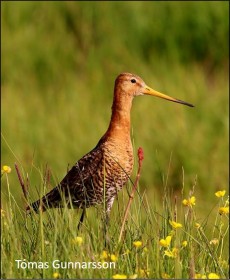 Over the last century, Icelandic black-tailed godwits have increased 10-fold in numbers and their breeding range has expanded throughout lowland Iceland. Although changing climatic conditions seem likely to have enabled this process, what is the mechanism? How might warmer conditions have contributed to this growth? This blog is a summary of a paper by José Alves and colleagues in Ecology & Evolution.
Over the last century, Icelandic black-tailed godwits have increased 10-fold in numbers and their breeding range has expanded throughout lowland Iceland. Although changing climatic conditions seem likely to have enabled this process, what is the mechanism? How might warmer conditions have contributed to this growth? This blog is a summary of a paper by José Alves and colleagues in Ecology & Evolution.
Setting the scene
If scientists are going to try to predict species’ responses to future climatic conditions, they will need to understand the ecological, behavioural and historical factors that influence how change happens. In other words, what mechanisms can link changes in climate with changes in population size and distribution?
 Appreciating how local climate effects can potentially scale up to population-level changes requires climate effects to be measured across a population. Iceland is a great place to study these processes as it has been getting warmer since at least 1845, as measured by one of the longest temperature time-series in the world. The country hosts internationally-important breeding populations of many migratory bird species, for which changing climatic conditions could have important implications, including Black-tailed Godwit. The data in the table alongside have been extracted from a report to AEWA that was discussed at the 12th Standing Committee in Jan/Feb 2017.
Appreciating how local climate effects can potentially scale up to population-level changes requires climate effects to be measured across a population. Iceland is a great place to study these processes as it has been getting warmer since at least 1845, as measured by one of the longest temperature time-series in the world. The country hosts internationally-important breeding populations of many migratory bird species, for which changing climatic conditions could have important implications, including Black-tailed Godwit. The data in the table alongside have been extracted from a report to AEWA that was discussed at the 12th Standing Committee in Jan/Feb 2017.
A booming population
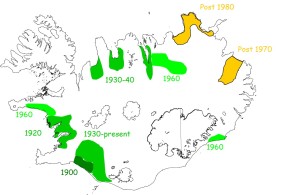
Expanding breeding range in Iceland
In the early 1900s, Black-tailed Godwits were restricted to the southern lowlands of Iceland but, since then, birds have gradually colonised coastal lowland areas throughout the country, with larger areas closer to occupied sites being colonised first (as described in this WaderTales blog). The population now numbers over 50,000 individuals, which is likely to represent an approximately 10-fold increase over the last century.
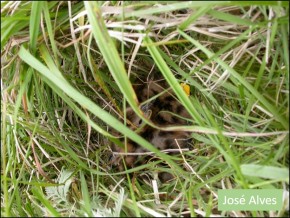
Newly hatched chicks, still in their nest-cup, well hidden in grass
Icelandic godwits are long-lived migratory shorebirds with a typical lifespan of between 15 and 20 years. They nest in lowland wetlands dominated by grasses or by dwarf birch and sedges. They hide their nests, which means that they require sufficiently tall vegetation to conceal the nest and an incubating adult. Both vegetation growth and the timing of emergence of invertebrate prey for wader chicks are strongly temperature-dependent, particularly at high latitudes, which means that the timing of nesting and the growth-rate of chicks are likely to be influenced by local temperatures.
 Over eight years, during which temperatures in Iceland varied substantially, José Alves and colleagues were able to quantify the influence of temperature on laying dates and the duration of the pre-fledging period of Icelandic godwits, and the subsequent influence of hatching dates on recruitment of chicks to the wintering or subsequent breeding population. The authors then used these relationships to model how the timing of breeding and the annual recruitment of juveniles into the breeding population may have contributed to population growth and the successful colonisation of new (and now warmer) parts of Iceland.
Over eight years, during which temperatures in Iceland varied substantially, José Alves and colleagues were able to quantify the influence of temperature on laying dates and the duration of the pre-fledging period of Icelandic godwits, and the subsequent influence of hatching dates on recruitment of chicks to the wintering or subsequent breeding population. The authors then used these relationships to model how the timing of breeding and the annual recruitment of juveniles into the breeding population may have contributed to population growth and the successful colonisation of new (and now warmer) parts of Iceland.
Catch your godwits
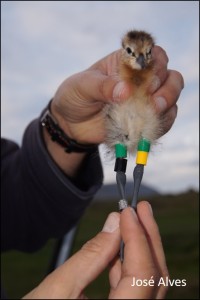 Black-tailed Godwits are very good at hiding their nests and chicks! These three quotes from the paper help us to appreciate the effort that goes into establishing some of the key facts that underpin the modelling at the heart of this paper:
Black-tailed Godwits are very good at hiding their nests and chicks! These three quotes from the paper help us to appreciate the effort that goes into establishing some of the key facts that underpin the modelling at the heart of this paper:
- “Every nest was visited regularly and successful nests were revisited at the estimated hatching date, in order to capture and mark chicks and adults with individual combinations of colour-rings.”
- “For each family, one of the adults was captured using either a nest-trap or a hand-held net-gun.”
- “In 2012 and 2013, 32 godwit families were tracked during chick rearing, from hatching to fledging (n = 18) or brood loss (n = 14).”
Away from the main study area, volunteer ringers, led by Pete Potts of Farlington Ringing Group, caught, measured and colour-ringed chicks, thereby providing an assessment of hatching dates of chicks in other parts of Iceland.

The assessment of which chicks subsequently survived and recruited into the adult population relied heavily upon the observations of hundreds of birdwatchers, throughout Western Europe, who take the time and trouble to report sightings of colour-ringed birds. Examples of their dedication and links to other papers that rely upon their efforts can be found in Godwits and Godwiteers.
Major Findings
Effect of temperature on timing of breeding season events: In Icelandic godwits, mean laying dates were approximately 11 days earlier in the warmest of years than in the coldest (two-degrees Celsius lower). This earlier start to the breeding season is thought to be linked to faster vegetation growth in warmer springs. The lengths of the chick pre-fledging period varied by only about 3.6 days between the warmest and coldest years but this additional difference means that fledging can happen a fortnight earlier in the warmest of years.

 Probability of recruitment: Early-hatched chicks are more likely to survive and recruit into the adult population, and the 11-day advance in hatch dates in warm years equates to an increase in absolute recruitment probability of about 10%. The additional benefits of more rapid chick growth and fledging in warmer years probably further increases this differential. In cold years, when most nests are laid late, very few chicks are likely to recruit to the adult population. For example, in 2011, the coldest year recorded during the study, only about 16% of 118 ringed chicks recruited into the wintering population. Early-fledged chicks presumably have more time to improve body condition prior to migration, there is an increased probability of travelling in adult-dominated migratory flocks (see graphic from Gunnarsson 2006), and earlier departure for wintering areas may allow more time in which to find a favourable wintering location.
Probability of recruitment: Early-hatched chicks are more likely to survive and recruit into the adult population, and the 11-day advance in hatch dates in warm years equates to an increase in absolute recruitment probability of about 10%. The additional benefits of more rapid chick growth and fledging in warmer years probably further increases this differential. In cold years, when most nests are laid late, very few chicks are likely to recruit to the adult population. For example, in 2011, the coldest year recorded during the study, only about 16% of 118 ringed chicks recruited into the wintering population. Early-fledged chicks presumably have more time to improve body condition prior to migration, there is an increased probability of travelling in adult-dominated migratory flocks (see graphic from Gunnarsson 2006), and earlier departure for wintering areas may allow more time in which to find a favourable wintering location.
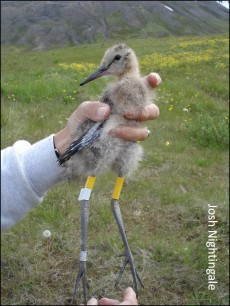 Regional variation: Traditional breeding sites are warmer, and so nests are likely to be earlier and incubation shorter, which means that more of the chicks from these areas are likely to survive and recruit into the population. The range expansion in this system could therefore have been driven by increased productivity and dispersal from traditionally colonised areas, supplemented by increased productivity within newly colonised – and now warmer – areas. Given the high levels of natal philopatry in Black-tailed Godwits (WaderTales blog about philopatry), the authors suggest that improved breeding conditions, following colonisation of new areas, have fuelled local population increases and further range expansion.
Regional variation: Traditional breeding sites are warmer, and so nests are likely to be earlier and incubation shorter, which means that more of the chicks from these areas are likely to survive and recruit into the population. The range expansion in this system could therefore have been driven by increased productivity and dispersal from traditionally colonised areas, supplemented by increased productivity within newly colonised – and now warmer – areas. Given the high levels of natal philopatry in Black-tailed Godwits (WaderTales blog about philopatry), the authors suggest that improved breeding conditions, following colonisation of new areas, have fuelled local population increases and further range expansion.
Are these findings applicable to other species?
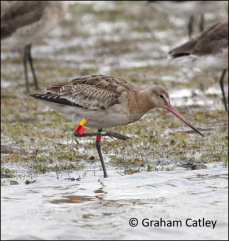
Sightings of colour-ringed juveniles, such as this one in eastern England, helped to establish recruitment rates.
The authors of this paper have been studying a species breeding at the northern limit of its range, in a country that has been subject to rapid climate change and in which there are relatively large differences in temperatures over quite small distances. This provides an ideal gradient over which to study change. Also, and unusually, it was possible to measure recruitment of chicks from right across Iceland, because of the colour-ring reports from observers. This set of circumstances have combined to enable the team to show that warming trends have the potential to fuel substantial increases in recruitment throughout Iceland, and thus to have contributed to local population growth and expansion across the breeding range. They propose that the same factors may be harder to tease apart for other species, in different environments, but that advances in lay dates and increased recruitment associated with early hatching may be key processes that drive population and range changes in migratory systems.
Paper

Juveniles gather together in the late summer, prior to departure

Graham (@grahamfappleton) has studied waders for over 40 years and is currently involved in wader research in the UK and in Iceland. He was Director of Communications at The British Trust for Ornithology until 2013 and is now a freelance writer and broadcaster.
Pingback: The waders of Northern Ireland | wadertales
It would be interesting to investigate whether there is any associated timing in the spring migration.
LikeLike
We know that individual birds don’t change timing of migration but birds entering the breeding population are dragging spring migration earlier: see https://wadertales.wordpress.com/2015/11/16/why-is-spring-migration-getting-earlier/
LikeLike
Reblogged this on Wolf's Birding and Bonsai Blog.
LikeLike
Pingback: January to June 2019 | wadertales
Pingback: Time to nest again? | wadertales
Pingback: Generational change | wadertales
Pingback: WaderTales blogs in 2019 | wadertales
Pingback: Nine red-listed UK waders | wadertales
Pingback: Wales: a special place for waders | wadertales
Pingback: Where to nest? | wadertales
Pingback: Why is spring migration getting earlier? | wadertales
Pingback: Eleven waders on UK Red List | wadertales
Pingback: Black-tailed Godwits and Volcanic Eruptions | wadertales
Pingback: When mates behave differently | wadertales
Pingback: UK waders: “Into the Red” | wadertales
Pingback: Inland feeding by coastal godwits | wadertales